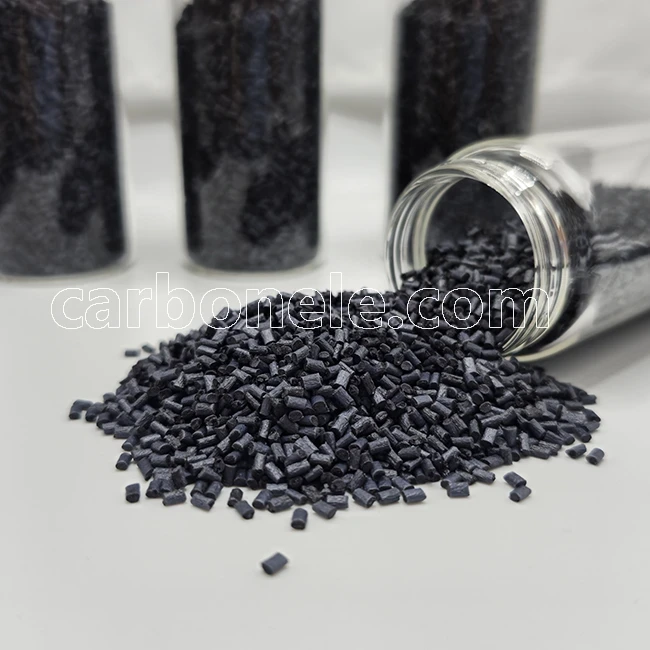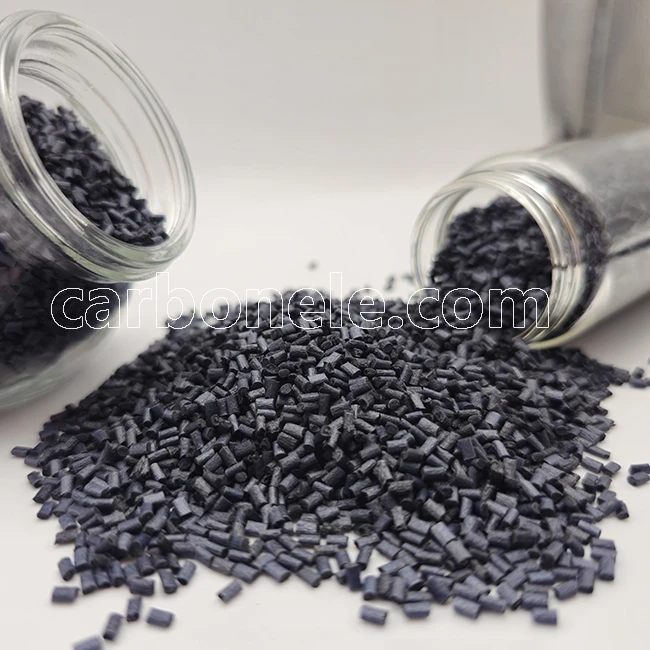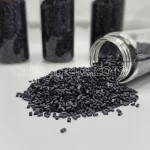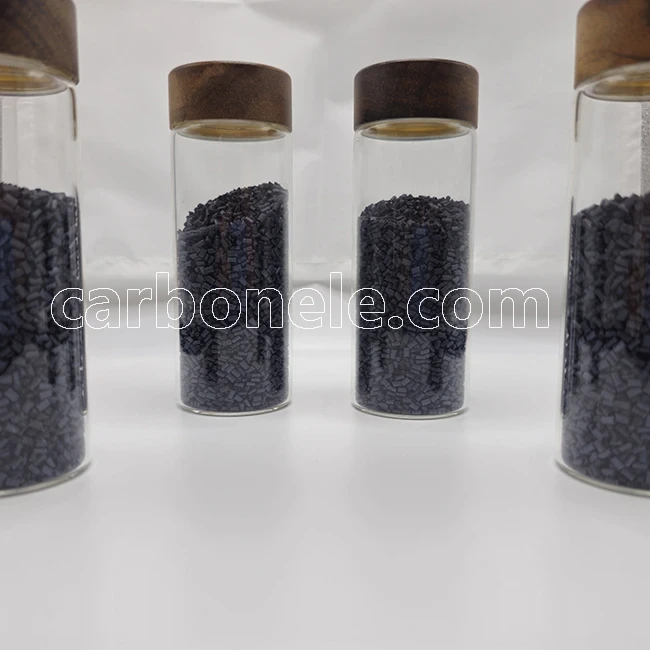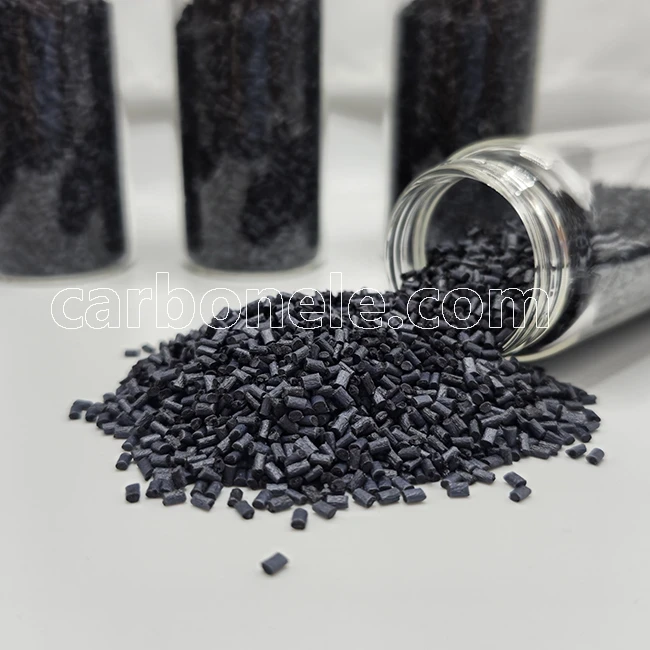
PBT CF10 Compounds Manufacturer Prices Per KG
10% Carbon Fiber Reinforced Polypropylene Thermoplastic Composite is a cutting-edge material. It consists of polypropylene and 10% carbon fibers. This material offers excellent mechanical strength and heat resistance. Its main functions and features include high stiffness and low weight. It finds wide applications in the automotive and aerospace industries. The future outlook for this material is promising.
- Manufacturer: Carbon New Material
- OEM/ODM: Acceptable
- Color: Black
- Free samples: ≤10kg
- MOQ: 100kg
- Port: Xiamen
- Model No.: PBT-CF-BCA1
Introduction – What’s PBT CF10?
PBT CF10 is a specialized material combining Polybutylene Terephthalate (PBT) with carbon fiber reinforcement. The “10” in its name signifies a 10% carbon fiber content, enhancing the inherent properties of the base polymer. This thermoplastic composite material is increasingly utilized in various advanced applications due to its superior performance characteristics. This article delves into the composition, features, synthesis methods, applications, and future prospects of this innovative composite.
Composition and Functional Characteristics – How to Get This Compounds?
PBT CF10 consists of Polybutylene Terephthalate, a semi-crystalline thermoplastic, and 10% carbon fibers. PBT itself is known for its high melting point, excellent mechanical strength, and resistance to chemical and thermal degradation. The addition of carbon fibers significantly boosts these properties. The carbon fibers lend the material increased stiffness, tensile strength, and dimensional stability, while also reducing its weight. This makes PBT 10CF an excellent choice for applications requiring high performance and durability.
Synthesis Methods
The production of PBT with 10% carbon fiber filled involves a two-step process. Initially, PBT resin is compounded with carbon fibers using melt mixing techniques. In this phase, the carbon fibers are dispersed throughout the polymer matrix under controlled temperature and pressure conditions. The resulting blend is then cooled and pelletized for further processing. This method ensures a homogeneous distribution of the carbon fibers within the PBT matrix, optimizing the mechanical properties of the final product.
Applications – What’re used in?
PBT CF10 has a broad spectrum of applications, particularly in industries where high performance and material efficiency are crucial. Here are a few notable examples:
1. Automotive Industry: PBT CF10 is widely used in automotive components such as engine covers, brackets, and structural parts. The composite’s high strength-to-weight ratio contributes to improved fuel efficiency and enhanced durability of the components.
2. Electronics: In the electronics sector, PBT CF10 is utilized for producing housings and casings for various devices. The material’s electrical insulation properties and thermal resistance make it ideal for safeguarding sensitive electronic components.
3. Industrial Applications: The material is also used in manufacturing industrial machinery parts that demand high mechanical strength and resistance to wear and tear.
Real-World Application Case Study
One notable application of PBT CF 10% is in the automotive sector, specifically for manufacturing gear shift levers. A prominent example involves Carbon (Xiamen) New Material, a leading producer in this field, utilizing PBT 10%CF to create a robust and lightweight gear shift lever for a major automotive manufacturer. The material’s superior mechanical properties ensure that the lever withstands the stresses of daily driving while reducing the overall weight of the vehicle. This application not only enhances the performance of the vehicle but also contributes to fuel efficiency by minimizing the weight of moving parts.
Development and Future Prospects
The development of PBT CF10 reflects a broader trend towards the use of advanced composite materials in various industries. As manufacturers and researchers continue to explore new applications, the demand for such materials is expected to grow. Innovations in processing techniques and enhancements in carbon fiber technology will likely drive further advancements in the properties and applications of PBT CF10.
The future prospects for this material are promising. As industries increasingly prioritize lightweight and high-strength materials, PBT CF10 is well-positioned to meet these demands. The ongoing development efforts by companies like Carbon (Xiamen) New Material ensure that PBT CF10 will continue to evolve, offering even more benefits and applications in the coming years.
PBT CF10% is a high-performance thermoplastic composite that combines Polybutylene Terephthalate with carbon fibers. Its superior mechanical properties, including enhanced strength and stiffness, make it an attractive choice for a variety of demanding applications. Through advanced synthesis methods and innovative uses, this material demonstrates significant potential for future development. Carbon (Xiamen) New Material Co., Ltd. plays a crucial role in advancing the capabilities and applications of PBT CF 10, highlighting its importance in the ongoing evolution of composite materials.
Learn more about CFRTPs or carbon fiber reinforced PBT compounds, please click here.
About Us
Integrating R&D, production and sales seamlessly, Carbon (Xiamen) New Material is steadfast in its commitment to providing top-notch carbon fiber reinforced thermoplastics. By relying on a highly professional R&D team, this company stands at the forefront of innovation. The R&D team is composed of experts and engineers who possess profound knowledge and extensive experience in the field. They are constantly exploring and pioneering new technologies and materials to enhance the performance and quality of the products. The modern advanced factory is equipped with state-of-the-art machinery and facilities. It adheres to strict quality control standards throughout the production process, ensuring that every product meets or exceeds industry standards. In addition to that, Carbon (Xiamen) New Material Co., Ltd. places great emphasis on meticulous pre-sales and after-sales services. The pre-sales team works closely with customers to understand their specific needs and provide tailored solutions. The after-sales service team is always ready to address any concerns or issues promptly, providing comprehensive support and ensuring customer satisfaction. Through these efforts, the company aims to create one-stop services and offer complete solutions of CFRTP products, establishing a strong reputation and trust in the market.

Advanced Laboratory Equipment
The advanced laboratory equipment of Carbon (Xiamen) New Material Co., Ltd. plays a crucial role in its research and development and quality control processes. These advanced laboratory equipment cover multiple fields and functions. For example, high-precision material analysis instruments can conduct precise composition analysis of raw materials and finished products to ensure that the products meet strict quality standards. There are also advanced mechanical property testing equipment used to evaluate key performance indicators such as the strength, toughness and durability of materials. Thermal performance testing equipment can help researchers understand the behavior of materials under different temperature conditions, which is essential for developing products that adapt to various environments. In addition, microstructure analysis equipment enables scientists to closely observe the microstructure of materials, providing a strong basis for optimizing material performance. These advanced laboratory equipment not only improve the R&D efficiency and product quality, but also provide strong support for Carbon (Xiamen) New Material Co., Ltd. to maintain a leading position in the highly competitive market. They are an important guarantee for the company's continuous innovation and development, helping the company provide customers with better and more reliable new material solutions.

Frequently Asked Questions
Carbon (Xiamen) New Material Co., Ltd. aims to provide buyers with "one-stop" worry-free high-quality services. Here you can find all information about carbon fiber engineering plastics. If you still have questions, please send us an email for consultation!
-
How can I contact the manufacturer of a product that interests me?
When you find a product you are interested in, you can contact the manufacturer directly by sending an email and we will get back to you as soon as possible.
-
How do I find the products that interest me?
All you need to do is enter the keyword, product name in the search window and press the Enter key on your keyboard. Your search results page will then be displayed. You can also search within the product category pages on the home page. Each category is divided into subcategories, allowing you to refine your search and find products that interest you.
-
Where will I find a buying guide?
Please contact our after-sales service directly and we will provide you with a comprehensive operating guide.
-
What are CF Reinforced Thermoplastic Composites?
CF Reinforced Thermoplastic Composites are materials where carbon fibers are incorporated into a thermoplastic matrix. They combine the strength and stiffness of carbon fibers with the processability and recyclability of thermoplastics. For instance, they are used in automotive parts like bumper beams.
-
What are the benefits of CF Reinforced Thermoplastic Composites over traditional composites?
The key benefits include faster production cycles, easier recyclability, and better impact resistance. They also offer design flexibility. An example is in the manufacturing of consumer electronics casings where complex shapes can be achieved more easily.
-
How are CF Reinforced Thermoplastic Composites processed?
Common processing methods include injection molding, extrusion, and compression molding. Injection molding is widely used for mass production. For example, in the production of small components for the medical industry.
-
What industries use CF Reinforced Thermoplastic Composites?
They are utilized in aerospace, automotive, medical, and sports equipment industries. In aerospace, they can be found in interior components. In the medical field, they might be used in prosthetics.
-
How does the carbon fiber content affect the properties of the composites?
Higher carbon fiber content generally leads to increased strength and stiffness but may reduce ductility. A moderate content is often balanced for specific applications. For example, a higher content might be preferred in structural parts of a race car.
-
What are the challenges in using CF Reinforced Thermoplastic Composites?
Challenges include higher material costs, complex processing equipment requirements, and ensuring uniform fiber dispersion. Issues with adhesion between the fibers and the matrix can also arise. An example is in achieving consistent quality in large-scale production.







